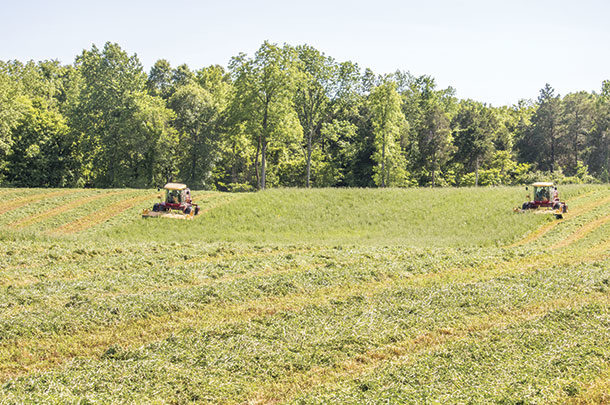Even the slightest misstep in the process can cost valuable quality and digestibility. So why let a decision like what type of mower to use be made lightly? Let’s look at two of the most popular mower types – sickle bar and disc mowers – as well as some of the concerns that go with their use.
Sickle bar
The sickle bar mower has been the traditional mechanized tool for mowing hay for over 100 years, with the original mowers drawn by horses. In the first models, the blade reciprocation was powered by the rolling iron wheels as the horses pulled it. The design today is much the same as it was then.
The mower works by moving triangular blades back and forth between stationary guard fingers. Each back-and-forth action shears off any grass or vegetation between the stationary fingers. This type of mower can be used to cut hay as well as for other general mowing duties.
The best sickle bar mowers currently being produced use a double action where the guard moves in the opposite direction from the blades. This doubles the blade speed and also greatly reduces machine vibration, making it quieter, more comfortable to use and longer-lasting.
Some of the advantages to using a sickle bar mower include a less expensive purchase price, less tractor horsepower needed, a large cutting swath and an angled mowing capacity. The disadvantages are a slower forward speed, and this mower can become easily clogged when cutting in dense or lodged vegetation.
Disc
Disc mowers were invented as a logical progression from the sickle bar design. Instead of blades moving back and forth on the cutter bar, they are mounted on several small discs that rotate at high speeds, mounted on top of the cutter bar. Generally, there are two free-swinging blades bolted to each disc. The discs are driven either by a shaft or gears inside the cutter bar.
Like a sickle bar, the cutter bar essentially slides along the ground, which is what controls the cutting height. Advantages to using a disc mower include no clogging issues and higher cutting speeds. Disadvantages are the need for hydraulics, more horsepower and weight needed for the tractor, and the expense of repair.
Now, after searching through numerous internet forage chat sites, there is much debate among forage growers as to which mower is best suited for which situations. Much like any equipment decision, price becomes a larger factor over suitability. There are a few other considerations to look at before making a mower decision.
Factors to watch
Watch cutting height: The advantage of faster ground speed has led many forage producers to trade in their sickle bar mowers for a disc mower. Not only are disc mowers faster, but they can certainly be more forgiving of hitting a rock or anthill. Hitting something hard with a sickle bar mower often means downtime to replace either a guard or knife section or both.
Not only are disc mowers getting faster ground speeds, but they are leaving less stubble. A closer mowing height means more forage, right? Not really. For forages like alfalfa, it may not be a major concern because the nutrients from early regrowth come from the taproot, not the stubble. But with grasses, the plant depends on the reserves at the bottom of the stem for nutrients to begin regrowth.
So the lower you mow, the slower the regrowth will be. Both the sickle bar and disc mower are designed to slide along the ground, so adjustments have to be made to raise cutting height, like the addition of high skid shoes. So important questions to ask when purchasing include: How high can it cut? Are there additional pieces to buy to raise the cutting height?
Adding a conditioner: Efficient drying is one of the most important factors in harvesting high-quality forage. A hay conditioner crimps and crushes newly cut forage to promote faster and more even drying.
The stand-alone conditioner is no longer used on most farms since the conditioner has been incorporated into mower-conditioners, which combine the mower and conditioner into a single machine. Both the sickle bar and disc mower can be purchased in combination with a conditioner.
It is always important before making an investment in a new piece of equipment to do more than look at the price. In addition to its cost, consider your operation and other implements and how they will all work together.
It is also valuable to remember the ultimate goal is to harvest the highest-quality forage possible, and the right equipment, calibrated to the right specifications, can help achieve that goal. ![]()
PHOTO: Beyond price, different types of mowers present diverse forage harvesting challenges and options. Knowing the differences should drive purchase decisions. Photo by Lynn Jaynes.
Carole Knight is an extension educator – Bulloch County at the University of Georgia. Email Carole Knight.










